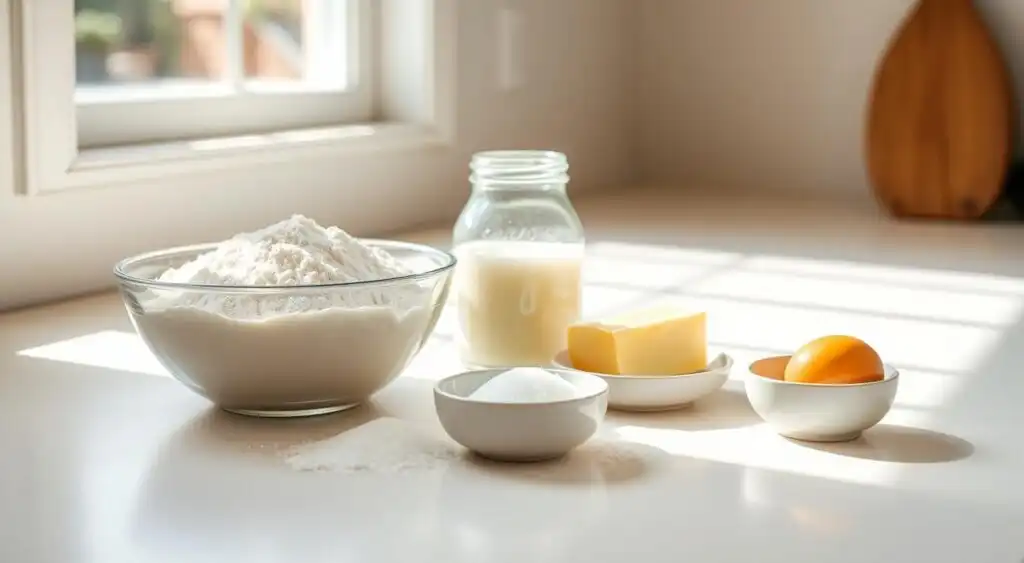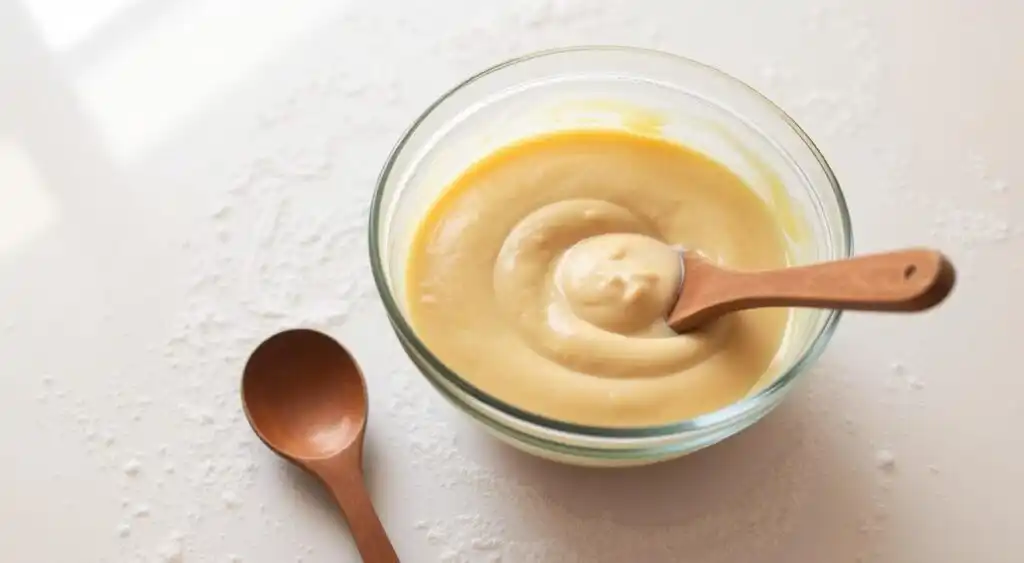There’s something magical about biting into a warm, golden-brown hoe cake—crispy and soft on the inside. It’s a taste of Southern tradition, a dish born from resourcefulness and a love for simple, hearty food.
These little delights have been a staple for generations, originally cooked over an open fire. Today, they’re just as beloved for their versatility. Enjoy them sweet with honey or savory alongside the fried chicken.
What makes this recipe special? It’s quick and easy and uses basic pantry staples like flour and a cup of milk. Whether you’re a seasoned cook or a beginner, you’ll love how effortlessly it comes together.
Ready to bring a piece of Southern comfort to your table? Let’s get started.
Table of Contents
What Is a Hoe Cake?
Few foods capture Southern tradition like crispy-edged hoe cakes. These skillet-baked breads blend cornmeal or flour into a golden, pancake-like treat. Their name traces back to 1745, when cooks used farm tools as makeshift griddles.
A Southern Staple with a Rich History
Born from resourcefulness, early versions of hoe cakes were cooked on hoes over open flames—a testament to their humble origins. The Oxford Dictionary traces the term back to early American settlers, who relied on simple ingredients to create these golden, crispy delights. Today, hoe cakes remain a cherished part of Southern cuisine, often fried in bacon grease or oil to achieve that signature crunch.
Hoe Cake vs. Johnny Cake: What’s the Difference?
While some regions refer to them as “Johnny cakes,” traditional Southern hoe cakes often incorporate flour, making them slightly different from their northern counterparts. Hoe cakes tend to be denser, resembling a rustic flatbread, whereas Johnny cakes are typically fluffier and more akin to pancakes. Over the years, modern variations—like the viral hot water cornbread—have emerged, proving that this dish continues to evolve while honoring its deep-rooted history.
Much like the simplicity and versatility of hoe cakes, other classic comfort foods, such as a banana bread recipe with cake mix, showcase how staple ingredients can transform into beloved dishes with minimal effort. Whether it’s a quick shortcut for banana bread or a centuries-old Southern cornbread recipe, the heart of home cooking remains the same—turning everyday ingredients into something special.
“A cast-iron skillet and patience are all you need for perfection.”
Serve them warm with butter or syrup. Whether sweet or savory, they’re a bite of history.
Ingredients and Tools for the Perfect Hoe Cake
The secret to perfect hoe cakes lies in quality ingredients and the right tools. Whether you prefer them savory or sweet, a few essentials ensure crispy edges and tender centers every time.

Essential Ingredients for Authentic Flavor
Start with these basics:
- Flour: Self-rising or all-purpose flour forms the base. For gluten-free versions, use a 1:1 substitute.
- Liquid: Buttermilk adds tang, but regular milk works too. Hot water (about 1 cup) creates a *fluffy texture*.
- Fat: Vegetable oil, melted butter, or bacon grease infuses richness.
For extra flavor, mix in jalapeños or crumbled bacon. Sweet lovers can drizzle honey or syrup after cooking.
Must-Have Kitchen Tools
Your equipment matters as much as your ingredients:
- Cast iron skillet: Ensures even heat for that golden crust. Preheat it before adding batter.
- Mixing bowl: A large one prevents spills when combining dry and wet ingredients.
- Measuring cups: Precision is key—especially for the flour and liquid ratios.
“A well-seasoned skillet is non-negotiable for authentic Southern results.”
With these staples, you can craft hoe cakes worthy of any breakfast or barbecue.
Step-by-Step Hoe Cake Recipe
Mastering the art of perfect hoe cakes starts with nailing the basics—the batter, heat, and timing. Follow these steps for golden, crispy-edged results every time.
- Prepare the Batter – Begin by combining cornmeal, flour, baking powder, and a pinch of salt in a mixing bowl. For added richness, some variations even incorporate a touch of sugar or a hint of vanilla, much like a banana bread recipe with cake mix enhances its flavor. Gradually add buttermilk or water while stirring until the mixture reaches a thick but pourable consistency.
- Heat the Skillet – Traditional hoe cakes are best cooked in a cast-iron skillet. Preheat your skillet over medium heat and add a generous amount of oil or butter. The right temperature ensures the cakes develop a crispy, golden crust while staying soft inside.
- Cook to Perfection – Spoon small amounts of batter onto the hot skillet, forming pancakes about 3–4 inches in diameter. Let them cook undisturbed for about 2–3 minutes until bubbles form on the surface and the edges appear set. Flip carefully and cook for another 1–2 minutes until both sides are golden brown.
- Serve and Enjoy – Hoe cakes are incredibly versatile! Serve them warm with butter, honey, or syrup for a classic Southern touch, or pair them with savory dishes like fried chicken or collard greens. Just like a banana bread recipe with cake mix creates a deliciously simple treat, hoe cakes offer an easy yet satisfying addition to any meal.
By following these steps, you’ll achieve perfectly crispy, golden hoe cakes every time—simple, delicious, and full of Southern tradition.
Preparing the Batter
To create the perfect base for your banana bread recipe with cake mix, start by combining your dry ingredients. In a large mixing bowl, whisk together flour, cornmeal, and a pinch of salt to ensure an even distribution of flavors. For an extra flaky and tender texture, cut in cold butter or shortening using a pastry cutter or fork until the mixture resembles coarse crumbs. This step is crucial for achieving a light, delicate crumb in your final bake.
Next, incorporate the wet ingredients gradually. Whether you’re using buttermilk, hot water, or another liquid, pour it in slowly while stirring gently. Overmixing at this stage can lead to a dense texture, which is why it’s essential to mix just until the ingredients are combined. If you’re using a cake mix as a base for your banana bread, this is the time to fold in mashed ripe bananas, eggs, and any additional flavor enhancers like vanilla extract or cinnamon.
Allowing the batter to rest for about five minutes before baking helps activate the leavening agents, resulting in a soft and fluffy texture. This step is particularly important when using a cake mix, as it allows all the ingredients to blend seamlessly, ensuring a moist and delicious banana bread.

Cooking Techniques for Crispy Edges
Achieving crispy edges in your cakes requires the right techniques, whether using a stovetop or oven. A well-heated pan, the right amount of fat, and proper flipping timing all contribute to the perfect texture.
Stovetop Method for Crispy Perfection
For the crispiest edges, a cast-iron skillet is ideal due to its superior heat retention. Heat the skillet over medium heat and test its readiness by flicking a few water droplets onto the surface—if they sizzle and evaporate instantly, the pan is hot enough. Add about 1 tablespoon of oil or bacon grease to create a non-stick surface and enhance the flavor.
Once the pan is ready, pour ¼ cup of batter per cake. Cook each one for about 2–3 minutes per side until golden brown. Flip only when bubbles form on the surface, ensuring even cooking. For an extra crispy texture, press lightly with a spatula while cooking. If you’re using a banana bread recipe with cake mix, this method works well for achieving a caramelized, slightly crunchy exterior while keeping the inside soft and moist.
Oven-Baked Alternative for Even Cooking
If you prefer a more hands-off approach, baking is a great alternative. Preheat the oven to 425°F and lightly grease a baking sheet or cast-iron skillet. Pour the batter into the prepared pan and bake for 15–20 minutes. This method produces evenly cooked cakes with a slightly softer crust compared to the stovetop version, making it an excellent choice if you enjoy a more uniform texture.
For those making banana bread with cake mix, baking can enhance the flavors, allowing the ingredients to meld together beautifully while creating a slightly crisp outer layer. If you want a firmer texture, you can finish the baked cakes under the broiler for the last 2 minutes to develop extra crispiness.
Whichever method you choose, adjusting the heat and cooking time will help you achieve the perfect balance between crispy edges and a tender, flavorful center.
Serving Suggestions for Maximum Enjoyment
For the best experience, serve your banana bread warm with a generous spread of melted butter, a drizzle of honey, or a touch of maple syrup for added sweetness. If you’re feeling adventurous, try pairing it with savory dishes like BBQ ribs or smothered chicken—the subtle sweetness of banana bread perfectly balances the rich, smoky, and savory flavors.
If you’ve made a banana bread recipe with cake mix, you’ll find it has a delightfully soft texture and a slightly sweeter taste. This makes it an excellent companion for a morning coffee, an afternoon tea, or even as a quick dessert topped with whipped cream and fresh berries.
To keep your banana bread fresh, store any leftovers in an airtight container at room temperature for up to four days. If you prefer to enjoy it warm, simply reheat slices in a 350°F oven for about five minutes to restore their soft interior and slight crispness on the edges. For longer storage, freeze individual slices by wrapping them tightly in plastic wrap or aluminum foil to prevent freezer burn. When ready to enjoy, thaw at room temperature or warm in the oven for a freshly baked taste.
“The secret? A hot skillet and patience. Let each side develop that perfect crust.”
Conclusion
Simple, crispy, and full of flavor—this dish never disappoints. Whether you use flour or cornmeal, the result is a golden bread with endless possibilities. Serve it with butter at breakfast or alongside BBQ for dinner.
Tag @southernplate when you share your creations. Craving more Southern classics? Try our fluffy biscuits or skillet cornbread next.
Ready to cook? Heat your skillet and let the aroma fill your kitchen tonight!
Check out our latest article for more insights, and follow us on Facebook for updates! and connect with us on Pinterest